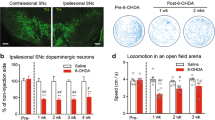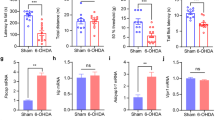Abstract
Non-motor symptoms are increasingly identified to present clinical and diagnostic importance for Parkinson’s disease (PD). The multifactorial origin of pain in PD makes this symptom of great complexity. The dopamine precursor, l-DOPA (l-3,4-dihydroxyphenylalanine), the classic therapy for PD, seems to be effective in pain threshold; however, there are no studies correlating l-DOPA-induced dyskinesia (LID) and nociception development in experimental Parkinsonism. Here, we first investigated nociceptive responses in a 6-hydroxydopamine (6-OHDA)-lesioned rat model of Parkinson’s disease to a hind paw-induced persistent inflammation. Further, the effect of l-DOPA on nociception behavior at different times of treatment was investigated. Pain threshold was determined using von Frey and Hot Plate/Tail Flick tests. Dyskinesia was measured by abnormal involuntary movements (AIMs) induced by l-DOPA administration. This data is consistent to show that 6-OHDA-lesioned rats had reduced nociceptive thresholds compared to non-lesioned rats. Additionally, when these rats were exposed to a persistent inflammatory challenge, we observed increased hypernociceptive responses, namely hyperalgesia. l-DOPA treatment alleviated pain responses on days 1 and 7 of treatment, but not on day 15. During that period, we observed an inverse relationship between LID and nociception threshold in these rats, with a high LID rate corresponding to a reduced nociception threshold. Interestingly, pain responses resulting from CFA-induced inflammation were significantly enhanced during established dyskinesia. These data suggest a pro-algesic effect of l-DOPA-induced dyskinesia, which is confirmed by the correlation founded here between AIMs and nociceptive indexes. In conclusion, our results are consistent with the notion that central dopaminergic mechanism is directly involved in nociceptive responses in Parkinsonism condition.




Similar content being viewed by others
References
Barceló AC, Filippini B, Pazo JH (2012) The striatum and pain modulation. Cell Mol Neurobiol 32(1):1–12. https://doi.org/10.1007/s10571-011-9737-7
Broen MP, Braaksma MM, Patijn J, Weber WE (2012) Prevalence of pain in Parkinson’s disease: a systematic review using the modified QUADAS tool. MovDisord 27:480–484. https://doi.org/10.1002/mds.24054
Cenci MA, Lee CS, Björklund A (1998) l-DOPA-induced dyskinesia in the rat is associated with striatal overexpression of prodynorphin- and glutamic acid decarboxylase mRNA. Eur J Neurosci 10:2694–2706. https://doi.org/10.1046/j.1460-9568.1998.00285.x
Chang JW, Wachtel SR, Young D, Kang UJ (1999) Biochemical and anatomical characterization of forepaw adjusting steps in rat models of Parkinson's disease: studies on medial forebrain bundle and striatal lesions. Neuroscience 88(2):617–628
Chen Y, Mao CJ, Li SJ, Wang F, Chen J, Zhang HJ, Li L, Guo SS, Yang YP, Liu CF (2015) Quantitative and fiber-selective evaluation of pain and sensory dysfunction in patients with Parkinson’s disease. Parkinsonism Relat 21:361–365. https://doi.org/10.1016/j.parkreldis.2015.01.008
Chudler EH, Dong WK (1995) The role of the basal ganglia in nociception and pain. Pain 60(1):3–38
Chudler EH, Lu Y (2008) Nociceptive behavioral responses to chemical, thermal and mechanical stimulation after unilateral, intrastriatal administration of 6-hydroxydopamine. Brain Res 1213:41–47. https://doi.org/10.1016/j.brainres.2008.03.053
Cobacho N, De la Calle JL, González-Escalada JR, Paíno CL (2010) Levodopa analgesia in experimental neuropathic pain. Brain Res Bull 83:304–309
Cury RG, Galhardoni R, Teixeira MJ, Dos Santos Ghilardi MG, Silva V, Myczkowski ML, Marcolin MA, Barbosa ER, Fonoff ET, Ciampi de Andrade D (2016) Subthalamic deep brain stimulation modulates conscious perception of sensory function in Parkinson's disease. Pain 157:2758–2765. https://doi.org/10.1097/j.pain.0000000000000697
Dieb W, Ouachikh O, Alves S, Boucher Y, Durif F, Hafidi A (2016) Nigrostriatal dopaminergic depletion increases static orofacial allodynia. J Headache Pain 17:11. https://doi.org/10.1186/s10194-016-0607-z. Epub2016Feb 17
Djaldetti R, Shifrin A, Rogowski Z, Sprecher E, Melamed E, Yarnitsky D (2004) Quantitative measurement of pain sensation in patients with Parkinson disease. Neurology 62:2171–2175
Evans AH, Lawrence AD, Potts J, Appel S, Lees AJ (2005) Factors influencing susceptibility to compulsive dopaminergic drug use in Parkinson disease. Neurology 65:1570–1574. https://doi.org/10.1212/01.wnl.0000184487.72289.f0.
Fil A, Cano-de-la-Cuerda R, Muñoz-Hellín E, Vela L, Ramiro-González M, Fernández-de-Las-Peñas C (2013) Pain in Parkinson disease: a review of the literature. ParkinsonismRelatDisord 19:285–294. https://doi.org/10.1016/j.parkreldis.2012.11.009
Gao X, Zhang Y, Wu G (2000) Effects of dopaminergic agents on carrageenan hyperalgesia in rats. Eur J Pharmacol 406:53–58. https://doi.org/10.1016/S0014-2999(00)00649-X
Gerdelat-Mas A, Simonetta-Moreau M, Thalamas C, Ory-Magne F, Slaoui T, Rascol O, Brefel-Courbon C (2007) Levodopa raises objective pain threshold in Parkinson’s disease: a RIII reflex study. J NeurolNeurosurg Psychiatry 78:1140–1142. https://doi.org/10.1136/jnnp.2007.120212
Gerwyn M, Maes M (2017) Mechanisms explaining muscle fatigue and muscle pain in patients with myalgic encephalomyelitis/chronic fatigue syndrome (ME/CFS): a review of recent findings. CurrRheumatol Rep 19(1):1. https://doi.org/10.1007/s11926-017-0628-x
Gomes MZ, Del Bel EA (2003) Effects of electrolytic and 6-hydroxydopamine lesions of rat nigrostriatal pathway on nitric oxide synthase and nicotinamide adenine dinucleotide phosphate diaphorase. Brain Res Bull 62:107–115. https://doi.org/10.1016/j.brainresbull.2003.08.010
Gomes MZ, Raisman-Vozari R, Del Bel EA (2008) A nitric oxide synthase inhibitor decreases 6-hydroxydopamine effects on tyrosine hydroxylase and neuronal nitric oxide synthase in the rat nigrostriatal pathway. Brain Res 1203:160–169. https://doi.org/10.1016/j.brainres.2008.01.088
Granovsky Y, Schlesinger I, Fadel S, Erikh I, Sprecher E, Yarnitsky D (2013) Asymmetric pain processing in Parkinson’s disease. Eur J Neurol 20:1375–1382. https://doi.org/10.1111/ene.12188
Guigoni C, Li Q, Aubert I, Dovero S, Bioulac BH, Bloch B, Crossman AR, Gross CE, Bezard E (2005) Involvement of sensorimotor, limbic, and associative basal ganglia domains in l-3,4-dihydroxyphenylalanine-induced dyskinesia. J Neurosci 25:2102–2107. https://doi.org/10.1523/JNEUROSCI.5059-04.2005
Harper RP, Kerins CA, McIntosh JE, Spears R, Bellinger LL (2001) Modulation of the inflammatory response in the rat TMJ with increasing doses of complete Freund’s adjuvant. Osteoarthr Cartil 9(7):619–624. https://doi.org/10.1053/joca.2001.0461
Iwaszkiewicz KS, Hua S (2014) Development of an effective topical liposomal formulation for localized analgesia and anti-inflammatory actions in the complete Freund’s adjuvant rodent model of acute inflammatory pain. Pain Physician 17:19–35
Jarcho JM, Mayer EA, Jiang ZK, Feier NA, London ED (2012) Pain, affective symptoms, and cognitive deficits in patients with cerebral dopamine dysfunction. Pain 153:744–754. https://doi.org/10.1016/j.pain.2012.01.002. Epub2012 Mar 3.
Kaszuba BC, Walling I, Gee LE, Shin DS, Pilitsis JG (2017) Effects of subthalamic deep brain stimulation with duloxetine on mechanical and thermal thresholds in 6OHDA lesioned rats. Brain Res 1655:233–241. https://doi.org/10.1016/j.brainres.2016.10.025
Kirik D, Rosenblad C, Björklund A (1998) Characterization of behavioral and neurodegenerative changes following partial lesions of the nigrostriatal dopamine system induced by intrastriatal 6-hydroxydopamine in the rat. Exp Neurol 152(2):259–277
Lim SY, Farrell MJ, Gibson SJ, Helme RD, Lang AE, Evans AH (2008) Do dyskinesia and pain share common pathophysiological mechanisms in Parkinson’s disease? MovDisord 23:1689–1695. https://doi.org/10.1002/mds.22111
Lundblad M, Andersson M, Winkler C, Kirik D, Wierup N, Cenci MA (2002) Pharmacological validation of behavioural measures of akinesia and dyskinesia in a rat model of Parkinson's disease. Eur J Neurosci 15:120–132. https://doi.org/10.1046/j.0953-816x.2001.01843.x
Magnusson JE, Fisher K (2000) The involvement of dopamine in nociception: the role of D(1) and D(2) receptors in the dorsolateral striatum. Brain Res 855:260–266. https://doi.org/10.1016/S0006-8993(99)02396-3
Marques A, Chassin O, Morand D, Pereira B, Debilly B, Derost P, Ulla M, Lemaire JJ, Durif F (2013) Central pain modulation after subthalamic nucleus stimulation: a crossover randomized trial. Neurology 81:633–640. https://doi.org/10.1212/WNL.0b013e3182a08d00. Epub2013Jul 17
Mylius V, Engau I, Teepker M, Stiasny-Kolster K, Schepelmann K, Oertel WH, Lautenbacher S, Möller JC (2009a) Pain sensitivity and descending inhibition of pain in Parkinson’s disease. J NeurolNeurosurg Psychiatry 80:24–28. https://doi.org/10.1136/jnnp.2008.145995
Mylius V, Gerstner A, Peters M, Prokisch H, Leonhardt A, Hellwig D, Rosenow F (2009b) Low-frequency rTMS of the premotor cortex reduces complex movement patterns in a patient with pantothenate kinase-associated neurodegenerative disease (PKAN). NeurophysiolClin 39:27–30. https://doi.org/10.1016/j.neucli.2008.12.003
Padovan-Neto FE, Echeverry MB, Tumas V, Del-Bel EA (2009) Nitric oxide synthase inhibition attenuates l-DOPA-induced dyskinesias in a rodent model of Parkinson’s disease. Neuroscience 159:927–935. https://doi.org/10.1016/j.neuroscience.2009.01.034
Padovan-Neto FE, Echeverry MB, Chiavegatto S, Del-Bel E (2011) Nitric oxide synthase inhibitor improves de novo and long-term l-DOPA-induced dyskinesia in hemiparkinsonian rats. Front SystNeurosci 10:5–40. https://doi.org/10.3389/fnsys.2011.00040
Park J, Lim CS, Seo H, Park CA, Zhuo M, Kaang BK, Lee K (2015) Pain perception in acute model mice of Parkinson's disease induced by 1-methyl-4-phenyl-1,2,3,6-tetrahydropyridine (MPTP). Mol Pain 17:11–28. https://doi.org/10.1186/s12990-015-0026-1
Politis M, Wu K, Molloy S, G Bain P, Chaudhuri KR, Piccini P (2010) Parkinson’s disease symptoms: the patient’s perspective. Mov Disord 25:1646–1651. https://doi.org/10.1002/mds.23135
Saadé NE, AbouJaoude PG, Saadeh FA, Hamoui S, Safieh-Garabedian B, Kanaan SA, Atweh SF, Jabbur SJ (1997) Fos-like immunoreactivity induced by intraplantar injection of endotoxin and its reduction by morphine. Brain Res 769:57–65. https://doi.org/10.1016/S0006-8993(97)00662-8
Schestatsky P, Kumru H, Valls-Solé J, Valldeoriola F, Marti MJ, Tolosa E, Chaves ML (2007) Neurophysiologic study of central pain in patients with Parkinson disease. Neurology 69:2162–2169. https://doi.org/10.1212/01.wnl.0000295669.12443.d3
Schultz AM, Werba A, Ulbing S, Gollmann G, Lehofer F (1997) Peri-operative thoracic epidural analgesia for thoracotomy. Eur J Anaesthesiol 14:600–603
Shimizu T, Iwata S, Morioka H, Masuyama T, Fukuda T, Nomoto M (2004) Antinociceptive mechanism of l-DOPA. Pain 110:246–249
Skagerberg G, Lindvall O (1985) Organization of diencephalic dopamine neurones projecting to the spinal cord in the rat. Brain Res 342(2):340–351
Spears R, Dees LA, Sapozhnikov M, Bellinger LL, Hutchins B (2005) Temporal changes in inflammatory mediator concentrations in an adjuvant model of temporomandibular joint inflammation. J Orofac Pain 19:34–40
Takeda K, Sawamura S, Tamai H, Sekiyama H, Hanaoka K (2005) Role for cyclooxygenase 2 in the development and maintenance of neuropathic pain and spinal glial activation. Anesthesiology 103:837–844
Tassorelli C, Armentero MT, Greco R, Fancellu R, Sandrini G, Nappi G, Blandini F (2007) Behavioral responses and Fos activation following painful stimuli in a rodent model of Parkinson’s disease. Brain Res 1176:53–61. https://doi.org/10.1016/j.brainres.2007.08.012
Tinazzi M, Del Vesco C, Fincati E, Ottaviani S, Smania N, Moretto G, Fiaschi A, Martino D, Defazio G (2006) Pain and motor complications in Parkinson’s disease. J NeurolNeurosurg Psychiatry 77:822–825. https://doi.org/10.1136/jnnp.2005.079053
Vela L, Lyons KE, Singer C, Lieberman AN (2007) Pain-pressure threshold in patients with Parkinson’s disease with and without dyskinesia. Parkinsonism Relat Disord 13:189–192. https://doi.org/10.1016/j.parkreldis.2006.04.003
Wada A, Shizukuishi T, Kikuta J, Yamada H, Watanabe Y, Imamura Y, Shinozaki T, Dezawa K, Haradome H, Abe O (2017) Altered structural connectivity of pain-related brain network in burning mouth syndrome-investigation by graph analysis of probabilistic tractography. Neuroradiology 59:525–532. https://doi.org/10.1007/s00234-017-1830-2. Epub2017 Mar 30.
Wang CT, Mao CJ, Zhang XQ, Zhang CY, Lv DJ, Yang YP, Xia KL, Liu JY, Wang F, Hu LF, Xu GY, Liu CF (2017) Attenuation of hyperalgesia responses via the modulation of 5-hydroxytryptamine signalings in the rostral ventromedial medulla and spinal cord in a 6-hydroxydopamine-induced rat model of Parkinson's disease. Mol Pain 13:174480691769152. https://doi.org/10.1177/1744806917691525
Winkler C, Kirik D, Björklund A, Cenci MA (2002) L-DOPA-induced dyskinesia in the intrastriatal 6-hydroxydopamine model of Parkinson’s disease: relation to motor and cellular parameters of nigrostriatal function. Neurobiol Dis 10:165–186. https://doi.org/10.1006/nbdi.2002.0499
Wood JD (2008) Functional abdominal pain: the basic science. J Pediatr Gastroenterol Nutr 47:688–693. https://doi.org/10.1097/01.mpg.0000338961.40055.04
Acknowledgements
We would like to thank Célia Aparecida da Silva for the technical support. The equipment and drugs used in this work were acquired from FAPESP, CNPq, CAPES, Brazil. The experiments presented in this manuscript comply with the current Brazilian laws. This manuscript was revised by Elsevier Language Editing Services (Elsevier Webshop).
Author information
Authors and Affiliations
Corresponding authors
Ethics declarations
The experiments were performed in compliance with the recommendations of SBNeC (Brazilian Society of Neuroscience and Behavior), which are based on the US National Institutes of Health Guide for Care and Use of Laboratory Animals. The local Ethical Committee approved the protocol.
Competing Interests
The authors declare that they have no competing interests.
Rights and permissions
About this article
Cite this article
Nascimento, G.C., Bariotto-dos-Santos, K., Leite-Panissi, C.R.A. et al. Nociceptive Response to l-DOPA-Induced Dyskinesia in Hemiparkinsonian Rats. Neurotox Res 34, 799–807 (2018). https://doi.org/10.1007/s12640-018-9896-0
Received:
Revised:
Accepted:
Published:
Issue Date:
DOI: https://doi.org/10.1007/s12640-018-9896-0




